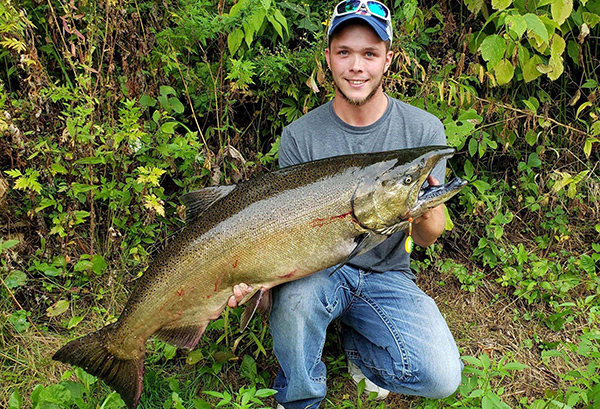By Louie Stout
 How big are the king salmon getting? Well, Danny Lunn of Portage, Ind. caught this 32.68-pound king from Salt Creek earlier this month. The fish was 42 inches long and had a 25 1/2-inch girth. He caught it on his own fire-tiger Custom Creek Spinner, 8-pound line and on a 9 1/2-foot rod. (Photo provided)How big are the king salmon getting? Well, Danny Lunn of Portage, Ind. caught this 32.68-pound king from Salt Creek earlier this month. The fish was 42 inches long and had a 25 1/2-inch girth. He caught it on his own fire-tiger Custom Creek Spinner, 8-pound line and on a 9 1/2-foot rod. (Photo provided)
How big are the king salmon getting? Well, Danny Lunn of Portage, Ind. caught this 32.68-pound king from Salt Creek earlier this month. The fish was 42 inches long and had a 25 1/2-inch girth. He caught it on his own fire-tiger Custom Creek Spinner, 8-pound line and on a 9 1/2-foot rod. (Photo provided)How big are the king salmon getting? Well, Danny Lunn of Portage, Ind. caught this 32.68-pound king from Salt Creek earlier this month. The fish was 42 inches long and had a 25 1/2-inch girth. He caught it on his own fire-tiger Custom Creek Spinner, 8-pound line and on a 9 1/2-foot rod. (Photo provided)
Chinook salmon are best known around the Great Lakes as “kings” for good reason.
Just look at what Lake Michigan has been producing this year – giant fish in the 25- to 35-pound class.
About five years ago, when the forage base was declining, you were lucky to catch a king much over 15 pounds.
Not only were the kings gobbling up most of the alewives back then, but they were reproducing naturally which put additional pressure on the forage base.
Studies showed alewife numbers were dwindling dangerously low, so Lake Michigan fish managers cut stocking numbers.
Well, those stocking cuts have worked, as illustrated by the number of giant fish caught around the lake this summer.
Kings have been packing on the pounds. That, coupled with the gradual improvement in alewife populations, have prompted fish managers to agree to increase king stockings in the future.
Most of the giant fish have been caught north of here although there have been a few 30 pounders caught on the southern end of the lake. Indiana’s best king fishing occurs in the spring.
Dickinson said hundreds of 15- to 20-pound-plus kings were caught on the south end of the lake last spring and early summer – before the fish really pack on weight.
“The proof is in the pudding when you consider the number of big kings being caught out there this year,” said Indiana Lake Michigan Biologist Ben Dickinson.
Last spring’s 20-pound fish could gain 10 pounds or more by this fall.
The increase in stocking numbers won’t be what they were during the hey-day, but enough that salmon anglers should be pleased.
The details were still being worked out at the time of this writing, but Dickinson said Hoosiers will see an increase.
“The Lake Michigan Committee believes the bait has rebounded and the predator/prey balance is sufficient enough to sustain a modest stocking increase,” Dickinson said.
Indiana will add back about half of the “chinook equivalents” that were cut a few years ago, which means there will be about a 20-25 percent increase over current stocking levels.
“How we get there depends upon hatchery logistics,” said Dickinson.
The chinook equivalent is a formula based upon what scientists believe the forage base can support. For example, three coho will consume the equivalent of what one king salmon will eat while in the lake.
Dickinson said the bulk of the increase will be kings, but the number of fish the hatchery can raise, to include cohos and steelhead, is limited due to the time the various fish species are in the hatchery.
It shouldn’t impact Indiana’s St. Joseph River stockings since kings aren’t stocked up here. But that doesn’t mean Hoosiers won’t hook into a giant.
“There are so many predators in the St. Joe that many of those 3.5-inch stocked kings we were stocking got eaten before they get back to the lake,” said Dickinson. “However, Michigan stocks kings in the lower St. Joe, so a few strays could wind up in South Bend. We see about 100 to 300 kings show up in the ladder each fall.”
Once the king increase is implemented, Indiana will stock Trail Creek, East Chicago and the Little Calumet River annually.
It will be a few years before anglers will notice the stocking increase. The additional fish will come from eggs taken this fall but those fish won’t be stocked until 2020. It will take 2 to 3 years in the lake for them to grow to giant size.
Even so, there should be plenty of those older, 20-pound-plus fish caught in Hoosier waters again next spring and early summer.
“It’s possible we will see 20 to 25s next spring,” said Dickinson. “The cuts we made in the past have brought some stability to the lake. We’ve seen big fish for three years in a row now that there’s more food to go around and I would expect that trend to continue in the near future.”


